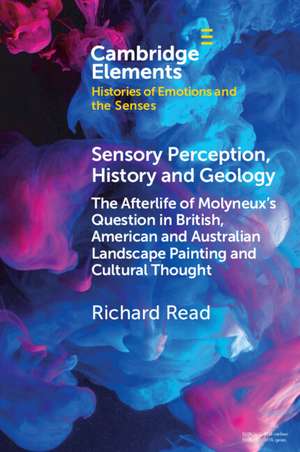Sensory Perception, History and Geology: The Afterlife of Molyneux's Question in British, American and Australian Landscape Painting and Cultural Thought: Elements in Histories of Emotions and the Senses
Autor Richard Readen Limba Engleză Paperback – 16 feb 2022
Preț: 143.38 lei
Nou
Puncte Express: 215
Preț estimativ în valută:
27.44€ • 29.79$ • 23.05£
27.44€ • 29.79$ • 23.05£
Carte tipărită la comandă
Livrare economică 23 aprilie-07 mai
Preluare comenzi: 021 569.72.76
Specificații
ISBN-13: 9781009095488
ISBN-10: 100909548X
Pagini: 75
Dimensiuni: 150 x 229 x 6 mm
Greutate: 0.13 kg
Ediția:Nouă
Editura: Cambridge University Press
Colecția Cambridge University Press
Seria Elements in Histories of Emotions and the Senses
Locul publicării:Cambridge, United Kingdom
ISBN-10: 100909548X
Pagini: 75
Dimensiuni: 150 x 229 x 6 mm
Greutate: 0.13 kg
Ediția:Nouă
Editura: Cambridge University Press
Colecția Cambridge University Press
Seria Elements in Histories of Emotions and the Senses
Locul publicării:Cambridge, United Kingdom
Cuprins
1. Seeing as Painting; 2. Hazlitt on Wilson; 3. Hazlitt on Cuyp; 4. Hazlitt on Poussin; 5. Ruskin's 'Innocence of the Eye'; 6. History: Molyneux's Question in America; 7. Geology; 8. Emerson's 'Eye-ball'; 9. Mixed Answers: Australia; 10. Conclusion; References.
Descriere
How Molyneux's Question shaped the conflict between empiricism and idealism in nineteenth-century British, American and Australian landscape painting and criticism.

















